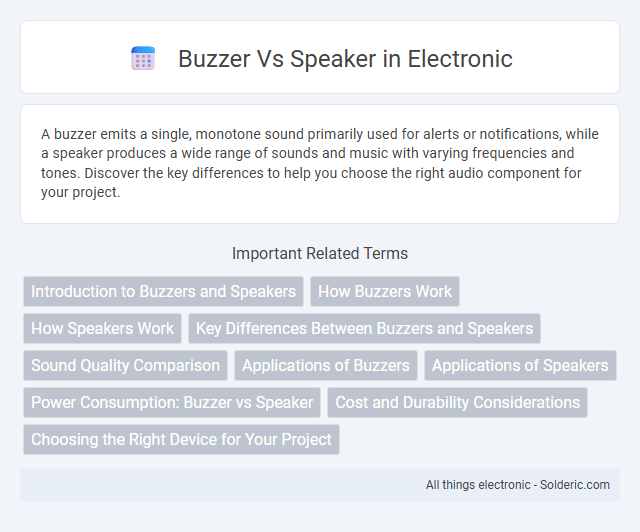A buzzer emits a single, monotone sound primarily used for alerts or notifications, while a speaker produces a wide range of sounds and music with varying frequencies and tones. Discover the key differences to help you choose the right audio component for your project.
Comparison Table
| Feature | Buzzer | Speaker |
|---|---|---|
| Function | Produces simple sound signals (beeps, buzzes) | Produces complex sounds, music, and voice |
| Sound Type | Monotone or fixed frequency | Wide frequency range |
| Power Consumption | Lower power usage | Higher power usage |
| Applications | Alarms, indicators, notifications | Audio output in devices, multimedia systems |
| Complexity | Simple design, easy to use | More complex design, requires amplifiers |
| Cost | Generally low cost | Varies; generally higher than buzzers |
Introduction to Buzzers and Speakers
Buzzers and speakers are both audio output devices used in various electronic applications to produce sound, but they function differently based on their design and purpose. Buzzers typically generate a fixed tone or beep sound through a simple oscillating circuit, making them ideal for alarms, notifications, and signaling devices. Speakers, however, use electromagnetic principles to convert electrical signals into a wide range of sounds, delivering richer audio experiences suitable for music, voice playback, and complex sound effects.
How Buzzers Work
Buzzers generate sound through rapid vibrations produced by an electric signal driving a diaphragm or piezoelectric element, creating a consistent and focused tone. Unlike speakers, buzzers are designed for simple alert sounds rather than complex audio playback, making them ideal for alarms and notifications. Your choice between a buzzer and speaker depends on whether you need clear, repetitive beeping or rich, varied sound.
How Speakers Work
Speakers convert electrical signals into sound through the vibration of a diaphragm connected to a voice coil in a magnetic field. When current passes through the voice coil, it creates a varying magnetic field that moves the diaphragm, producing sound waves. This process allows speakers to reproduce a wide range of frequencies and deliver high-fidelity audio in various applications.
Key Differences Between Buzzers and Speakers
Buzzers produce a fixed tone or sound, often used for alerts and alarms, while speakers deliver a wide range of sounds including music and voice with greater audio quality and versatility. Buzzers typically operate using simple on/off signals generating a monotone beep, whereas speakers convert electrical signals into variable sound waves for richer audio output. Understanding these key differences helps you choose the right device for applications requiring either simple notifications or complex sound reproduction.
Sound Quality Comparison
Buzzers produce a simple, monotone sound with limited frequency range, making them ideal for basic alerts but unsuitable for high-fidelity audio reproduction. Speakers deliver a wide frequency range and dynamic sound quality, enabling rich, clear audio suitable for music, voice, and complex sound effects. The difference in sound quality is primarily due to the speaker's diaphragm and coil design, which allows greater vibration control compared to the piezoelectric or electromagnetic mechanism in buzzers.
Applications of Buzzers
Buzzers are widely used in alarm systems, timers, and notification devices due to their ability to produce clear, attention-grabbing sounds. They are essential components in household appliances, smoke detectors, and automotive warning systems where simple sound signals are required. Unlike speakers, buzzers are more efficient for producing monotone or fixed-frequency alerts, making them ideal for status indicators.
Applications of Speakers
Speakers are widely used in various applications such as home audio systems, public address systems, and multimedia devices, providing high-quality sound reproduction for music, movies, and communication. Your entertainment setups, including televisions and gaming consoles, rely on speakers for immersive audio experiences. Industrial applications also benefit from speakers for clear announcements and alerts in large spaces.
Power Consumption: Buzzer vs Speaker
Buzzers typically consume less power than speakers, making them ideal for battery-powered or energy-efficient devices. Speakers require more power to produce a wider range of sound frequencies and higher volume levels. Your choice between a buzzer and speaker should consider power consumption needs alongside sound quality requirements.
Cost and Durability Considerations
Buzzers generally cost less and offer greater durability due to their simple construction and fewer moving parts, making them ideal for long-lasting, low-maintenance projects. Speakers, while more expensive and delicate because of their intricate components, provide higher sound quality and versatility for audio applications. Your choice depends on whether you prioritize budget and longevity or sound performance in your design.
Choosing the Right Device for Your Project
Choosing between a buzzer and a speaker depends on your project's audio requirements and complexity. Buzzers produce simple, monotone sounds ideal for alerts or alarms, consuming less power and requiring minimal circuitry, while speakers deliver a wider range of frequencies suitable for music or voice output but need more sophisticated amplification and signal processing. Consider factors such as sound quality, power consumption, and intended application to select the device that best fits your project's needs.
buzzer vs speaker Infographic

 solderic.com
solderic.com